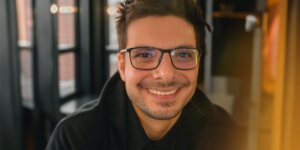
USC biomedical engineers have harnessed focused ultrasound to improve CRISPR, a revolutionary tool that enables the DNA in living organisms to be modified. Image/Wang Lab and Pepper Workshop.
Thanks to CRISPR, our medical specialists will soon have unprecedented control over how they treat and prevent some of our most challenging genetic disorders and diseases. CRISPR (Clustered Regularly Interspaced Short Palindromic Repeats) is a Nobel Prize-winning gene-editing tool, already widely used by scientists to cut and modify DNA sequences to turn genes on and off or insert new DNA that can correct abnormalities. CRISPR uses an enzyme known as Cas9 to cut and alter DNA.

Dwight C. and Hildagarde E. Baum Chair in Biomedical Engineering Peter Yingxiao Wang. Image/David Baillot, UC San Diego Jacobs School of Engineering.
Engineers in the USC Alfred E. Mann Department of Biomedical Engineering have now developed an update to the tool that will allow CRISPR technology to be even more powerful with the help of focused ultrasound. The resulting toolkit will allow CRISPR gene editing to be precisely targeted to the specific areas requiring treatment. The research team is already applying this discovery to refine their work in cancer immunotherapy.
The work is led by Dwight C. and Hildagarde E. Baum Chair in Biomedical Engineering Peter Yingxiao Wang, and members of the Wang Lab, including assistant professor of biomedical engineering Longwei Liu. It has been published in Nature Communications.
“CRISPR is revolutionary,” Wang said, “You can do genome or epigenome editing right in the cell nucleus — so that essentially, you can treat genetically-related diseases. But we are pushing it one step further to make it controllable. Instead of continuously editing the genome, we can now control it to be activated at a specific location and at a specific time using a non-invasive remote-controlled ultrasound wave. That’s the breakthrough.”
![PROFESSOR LONGWEI LIU [PHOTO COURTESY OF SHANSHAN QIN]](https://viterbischool.usc.edu/wp-content/uploads/2023/11/longwei-liu-e1699907627645-300x300.jpeg)
Research Assistant Professor Longwei Liu. Image/SHANSHAN QIN.
The latest work also uses cancer immunotherapy to demonstrate the power that focused ultrasound can add to the CRISPR toolbox, where the team harnesses both focused ultrasound CRISPR and immunotherapy to eradicate cancer cells in mouse studies. Wang said it was a tool that could be applied to a vast range of genetic disorders, diseases and autoimmune conditions.
“This is the first study that provides a very comprehensive, ultrasound-controllable CRISPR toolbox to knock out, activate, or silence a specific gene,” Liu said. “Combining that with immunotherapy, we showed enhanced tumor treatment in mice.”
Turning non-invasive ultrasound waves into a precision medicine powerhouse

Yiqian (Shirley) Wu, assistant professor at Peking University.
Wang said that one of the current disadvantages of CRISPR is that once it is activated and delivered into the body, it can continue its gene-editing function continuously.
“With a continuous expression, this will lead to the immunogenicity in humans because a human body will recognize the Cas9 positive cells and attack these kinds of cells,” Liu said
“Of course, that would trigger unwanted features. If it’s continuously working, sometimes you want to stop it, but you can’t. In our controllable system, you can flip it on and off whenever you want. So that’s the beauty of the system – providing another layer or controllability, and therefore precision,” Wang said.
The focused ultrasound avoids these issues by using ultrasound waves to initiate a temperature change at the precise site where the researchers want the CRISPR protein to activate. For instance, this location could be a tumor site where CRISPR needs to be used to modify the DNA of cancer cells to make them more susceptible to attack from CAR T-cell-based immunotherapy.
“So essentially, you connect the ultrasound wave through the temperature change to the production of the CRISPR molecule,” Wang said. “As soon as you turn it on, the CRISPR molecule will start to do its job wherever you want it. Then, after a certain time, it will start to decay by itself, it will be shut down for a period, and then you can turn it on again whenever you want.”
In terms of fighting cancer, the research team used the focused ultrasound-enabled CRISPR to target the telomere, a DNA-protein structure found at the end of chromosomes that protects the chromosome’s integrity and limits the number of times a cell can divide.
“The telomere has many, many repeats, and we use CRISPR, guided by ultrasound, to cut this telomere so that it will trigger the chromosome to be cut off at two ends,” Wang said. “Because they have a repeatable sequence, they will all be cut, and therefore, the tumor cell can no longer repair itself. It’s all broken. The cell will then undergo apoptosis and die.”
Wang said that from there, the cells would trigger cytokine production — proteins secreted by immune cells that act as messengers attracting other immune cells to the site to attack the already-dying tumor cells.

Wang Lab PhD student Peixiang He.
From there, the research team’s system triples down on the cancer-killing effect by releasing their SynNotch CAR T-cells – engineered cells that only attack cancer cells expressing a protein known as CD19 (which the CRISPR tool turns on), reducing the risk of harming healthy cells. Wang said that the surface of the tumor then acts like a training center for these CAR T-cells.
“And following their training, these SynNotch CAR T-cells will start to produce a CAR receptor on the surface to target the whole population of the tumor,” Wang said. “With those three factors together, we reach really high efficiency for tumor cleaning.”
The team has demonstrated promising lab results by harnessing the focused ultrasound CRISPR tool in combination with CAR T-cell technology.
“The result was surprisingly good,” Wang said. “In all the mice, the tumor was not only slowing in growth, but it also got cleared — the tumor essentially decayed and disappeared. So, these are very encouraging results.”
The work was also authored by Wang’s former PhD student Yiqian Shirley Wu, now an assistant professor at Peking University, along with Wang Lab PhD candidate Peixiang He and collaborators at UC San Diego, Georgia Institute of Technology and Emory University.
Published on December 2nd, 2024
Last updated on December 2nd, 2024












